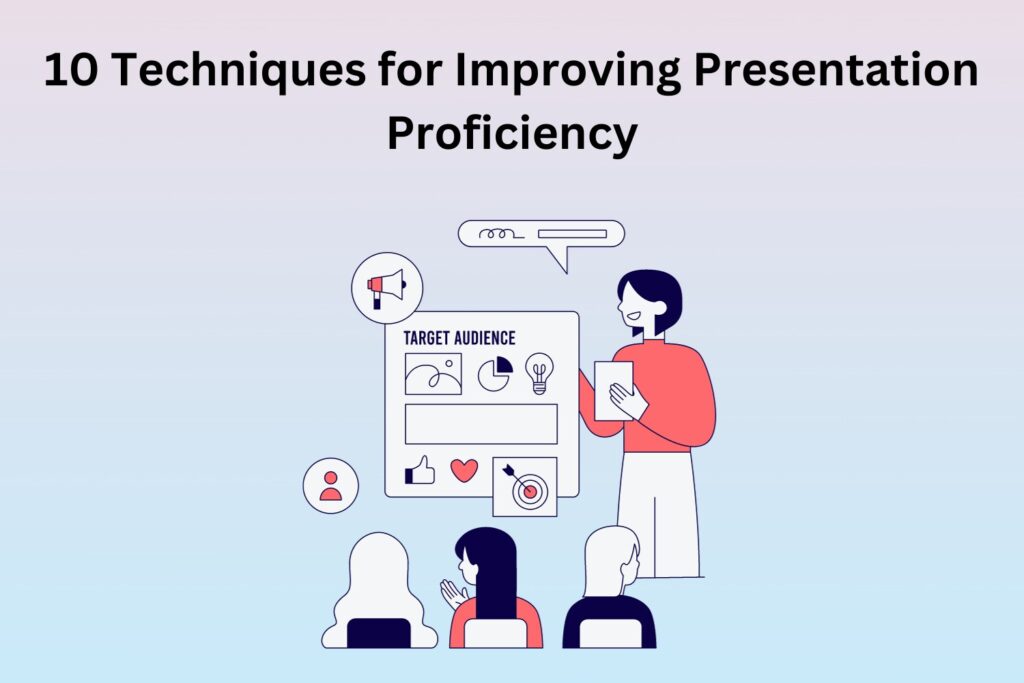A person’s success in the field of professional communication can be greatly impacted by their capacity to make an engaging and impactful presentation. Whether you’re a seasoned professional or just getting started, investing in improving your presentation abilities will pay off.
This blog post will discuss ten techniques for enhancing presentation skills and offer practical advice on How to Improve Presentation Skills. Enrolling in a Presentation Skills Course can help you advance your presentation abilities by delving deeper into the art and science of effective communication.
Table Of Contents
- Techniques for Improving Presentation Proficiency
- Enrolling in a Presentation Skills Course
- Conclusion
Techniques for Improving Presentation Proficiency
1. Understand Your Audience
The effectiveness of your presentation depends on how well you can tailor it to them. It’s important to consider your audience before you start writing your content. Consider their hobbies, background, and degree of knowledge. With this knowledge, you may modify your content, tone, and messaging to better connect with your audience and improve the relevance and engagement of your presentation.
2. Structure with Purpose
A presentation that is well-built and has a clear purpose is like a sturdy house. A compelling introduction should come first, then a well-organized body that logically delivers your main ideas and a compelling conclusion that includes a call to action. By giving your audience a road map, this framework makes it simpler for them to follow and remember the material.
3. Refine Your Non-Verbal Communication
Non-verbal cues are just as important to effective communication as spoken words. Be mindful of your gestures, facial emotions, and body language. To project confidence and establish a connection with your audience, keep your eyes open. Taking a presenting skills course will help you improve your nonverbal communication abilities and make sure your body language is consistent with the information you are trying to convey.
4. Master the Art of Vocal Variety
A monotonous presentation may not go well. Change your pitch, tone, and tempo to keep the listener interested. To project passion and authority, emphasise the most important topics, strategically use pauses, and modify your voice. Vocal diversity gives your presentation energy and keeps it from getting boring or formulaic.
5. Utilize Visual Aids Effectively
Adding slides or props to your presentation can increase its impact. But rather than competing with your message, they need to enhance it. Make sure your images are understandable, succinct, and pertinent to the content you are writing. You can learn how to make visually beautiful and powerful slides that strike the ideal balance between engagement and content by enrolling in a presentation skills course.
6. Engage Your Audience
Communication with your audience is a two-way street. Promote conversation by posing queries, conducting surveys, or holding talks. This keeps your audience engaged and gives you useful feedback on how well they understand and are interested in what you are saying. To enhance one’s presentation skills, one must acknowledge the significance of establishing a collaborative atmosphere.
7. Practise, Practise, Practise
When it comes to presentations, the saying “practice makes perfect” is accurate. Practise your presentation several times to become comfortable with the material, hone your delivery, and pinpoint areas that need work. You can record yourself, practise in front of a mirror, or show it to a dependable friend or coworker. You will get more polished and self-assured as you practise more.
8. Seek Constructive Feedback
One of the most effective tools for development is feedback. Seek out constructive criticism from mentors, colleagues, or even your audience following each presentation. Recognise what went well and where improvements may be made. With time, constructive criticism helps you improve your presentation skills and offers insightful observations.
9. Manage Nervousness
Being nervous is a typical problem while giving a presentation, but controlling it is essential. Before taking centre stage, practise calming techniques like deep breathing or visualisation. Accept your anxiety as a source of energy and channel it into creating a captivating and exciting presentation. Techniques for conquering anxiety and increasing confidence are frequently covered in a presenting skills course.
10. Stay Authentic
Effective communication requires authenticity. Be honest to yourself, sincere, and real. Authenticity is valued by audiences and fosters trust. When presenting, try not to take on a false persona but rather concentrate on being your best self. Your audience responds well to authenticity and is left with a positive impression.
Enrolling in a Presentation Skills Course
If you want to become a skilled presenter more quickly, you should think about taking a presentation skills course. These classes offer a controlled learning environment where you can get practical experience, individualised feedback, and professional supervision. An all-encompassing approach to increasing every facet of your presentation ability is provided by a presentation skills course, whether your goal is to improve your slide design, overcome stage fright, or refine your delivery.
Conclusion
It takes constant learning and improvement to become an expert at giving compelling presentations. You may improve your presenting abilities and leave a lasting impression on your audience by putting these ten strategies into practice. Recall that progress requires time, so exercise perseverance and patience. Your career can advance with the capacity to communicate with conviction, clarity, and confidence, whether you’re addressing a small group of people or a large one.
Additional:
- Understanding Litecoin: The Silver to Bitcoin’s Gold
- Winston AI – AI Content Detector | Review, Price, Feature
- Wellsaid Labs – Ai Voice Generator | Review, Price, And Feature

